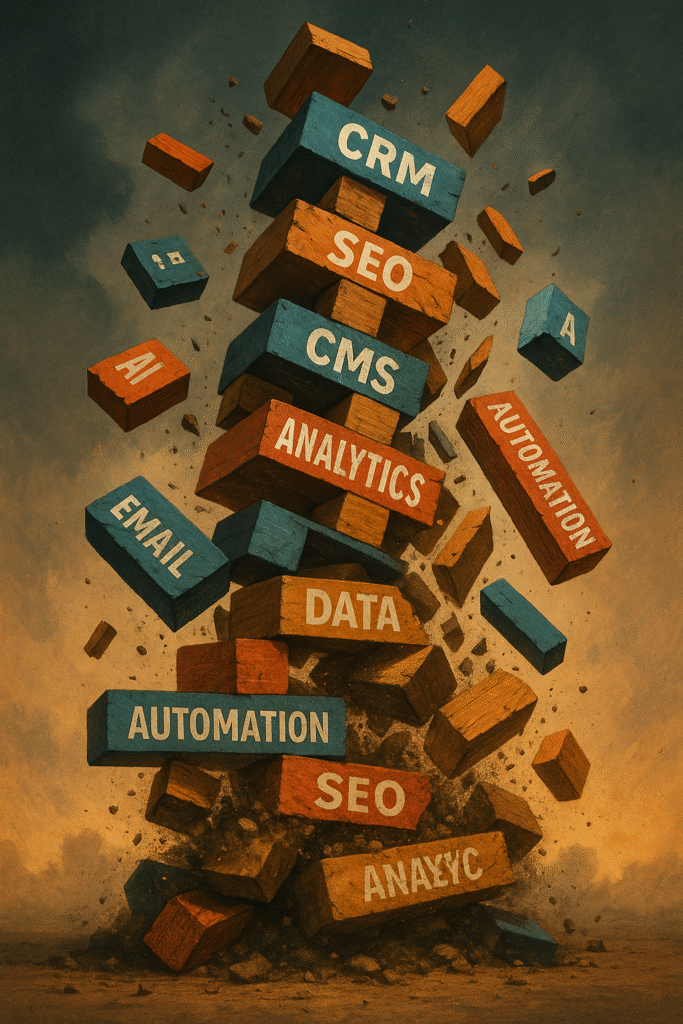It always starts with good intentions.
A new platform promises to fix your attribution gaps. Another promises smarter automation. A third offers real-time customer insights. The sales deck looks sharp. The demo is slick. The upside feels obvious.
So you buy it.
Six months later, your team is still stuck exporting reports into spreadsheets. Campaigns are stalled because integrations are broken. Your data dashboards say different things depending on which platform you check. And no one’s quite sure whether this tool or that one is actually responsible for driving revenue.
Sound familiar?
You’re not alone. Most B2B marketing teams are waking up to a hard truth:
their martech stack isn’t working.
Worse, it’s actively getting in the way.
When Tech Turns into a Tax
Martech is supposed to streamline growth. But in reality, many businesses are weighed down by a bloated, mismatched stack that’s been built reactively — not strategically.
This kind of stack doesn’t speed you up. It creates drag.
And you know it’s happening when:
-
You’re spending more time managing tools than executing campaigns.
-
Your data doesn’t match between systems, and no one trusts the reports.
-
You have tools no one is using — or even remembers buying.
-
Your team has to build workarounds for tools that were meant to automate.
-
You can’t clearly link spend on tech to impact on pipeline.
This is more than an operational headache. It’s a strategic liability. And it’s surprisingly common.
More Tech Doesn’t Equal More Capability
There’s a myth in marketing that maturity equals complexity — that sophisticated teams need dozens of tools to function at a high level.
The opposite is often true.
Look at the most effective companies — Apple, Stripe, Google. They aren’t trying to integrate 45 platforms. They build around simplicity, interoperability, and clarity of insight. Every system serves a defined purpose.
Meanwhile, many B2B businesses bolt on tool after tool, building a Frankenstack that no one fully understands — and that quietly drains budget, time, and trust.
The Hidden Cost of Complexity
The real issue isn’t just financial. It’s cognitive.
When your tech stack is bloated or misaligned, it makes it harder to answer the fundamental questions that drive strategy:
-
What’s working and what’s not?
-
Where are we leaking leads?
-
Which channels are truly delivering ROI?
-
What should we do more of — and what should we stop?
If your stack can’t help you answer these questions quickly and confidently, then what’s it doing?
Marketing is meant to move fast. Bloated stacks slow you down. They cause analysis paralysis, introduce blind spots, and turn basic campaign execution into a game of technical gymnastics.
Due Diligence: Don’t Just Buy It — Validate It
So how do you avoid the martech money pit? It starts long before the contract is signed.
Due diligence isn’t just procurement hygiene — it’s a strategic discipline. And done well, it can save you from months (or years) of inefficiency.
Here’s how to approach it:
Start with the problem, not the platform.
Know exactly what you’re trying to fix. Is it lead quality? Attribution? Workflow speed? If you can’t articulate the business case, you’re not ready to evaluate tools.
Audit before you add.
Map your existing stack. What’s actually being used? Where’s the overlap? What’s underperforming? Don’t buy blind.
Involve the people who’ll use it.
Marketing ops, sales, data teams, and actual users need a voice. They’ll spot integration issues, red flags, and training risks early.
Pilot before you commit.
Whenever possible, run a small-scale test. Define what success looks like. Measure it. If it’s clunky in pilot, it’ll be worse at scale.
Check the runway.
How well does the tool integrate with your ecosystem? Is the support any good? Are they shipping updates or standing still?
These aren’t just buying criteria — they’re signs of whether a tool will become a growth engine or another layer of stack fatigue.
A Better Martech Mindset
The goal isn’t to have fewer tools. It’s to have fewer pointless tools.
What matters is having a stack that’s:
-
Aligned to your actual business model
-
Integrated into your operational flow
-
Built around trusted, accessible data
-
Actively used and owned by your team
In short: your stack should serve your strategy. Not the other way around.
Looking Ahead: Martech in 2025 and Beyond
As we move into a more privacy-driven, AI-enabled marketing landscape, the pressure to prove ROI will only increase.
Budgets will tighten. Expectations will rise. And the days of “buy first, figure it out later” will come to an end.
Marketers will need to justify every tool in their stack — not with promises, but with performance. AI will become more prevalent, yes. But it will only deliver value if it’s deployed inside a well-structured, goal-driven system.
Which means now is the perfect time to step back, audit your stack, and make some hard decisions.
If It’s Not Helping You Grow, Why Keep It?
The best martech stack isn’t the biggest.
It’s the one that gets used, gets results, and gets out of the way.
If your current setup isn’t making your team faster, clearer, and more effective — it’s time to rethink.
At broden.ai, we help growth-focused marketers cut through the noise.
We’ll audit your stack, identify what’s working (and what’s not), and help you rebuild a leaner, smarter marketing engine.
Ready to take a fresh look at your stack?
Start your Martech Audit at broden.ai



